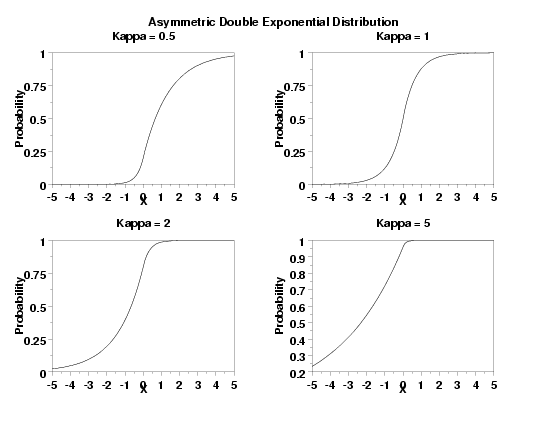

|
ADECDFName:
![F(x,kappa) = 1 - (1/(1+kappa**2))*EXP[-SQRT(2)*kappa*ABS(x)] x >= 0;
= (kappa**2/(1+kappa**2))*EXP[(-SQRT(2)/kappa)*ABS(x)] x < 0;
kappa > 0](eqns/adecdf.gif)
with
The standard asymmetric double exponential distribution can be
generalized with a location parameter,

in the above formula.
If The asymmetric double exponential distribution is also known as the asymmetric Laplace distribution.
<SUBSET/EXCEPT/FOR qualification> where <x> is a variable or a parameter; <k> is a positive number of parameter that specifies the value of the shape parameter; <loc> is an optional number or parameter that specifies the value of the location parameter; <scale> is an optional positive number or parameter that specifies the value of the scale parameter; <y> is a variable or a parameter (depending on what <x> is) where the computed asymmetric double exponential cdf value is stored; and where the <SUBSET/EXCEPT/FOR qualification> is optional.
LET Y = ADECDF(X1,K) PLOT ADECDF(X,K) FOR X = -5 0.01 5
 . These
parameterizations are related by: . These
parameterizations are related by:

The
By default, Dataplot uses the
To reset the
"A Class of Distributions Which Includes the Normal Ones", Azzalini, Scandinavian Journal of Statistics, 12, 171-178.
Y1LABEL Probability
X1LABEL X
LABEL CASE ASIS
TITLE CASE ASIS
CASE ASIS
Y1LABEL DISPLACEMENT 12
MULTIPLOT 2 2
MULTIPLOT CORNER COORDINATES 0 0 100 95
MULTIPLOT SCALE FACTOR 2
TITLE Kappa = 0.5
PLOT ADECDF(X,0.5) FOR X = -5 0.1 5
TITLE Kappa = 1
PLOT ADECDF(X,1) FOR X = -5 0.1 5
TITLE Kappa = 2
PLOT ADECDF(X,2) FOR X = -5 0.1 5
TITLE Kappa = 5
PLOT ADECDF(X,5) FOR X = -5 0.1 5
END OF MULTIPLOT
MOVE 50 97
JUSTIFICATIONC CENTER
TEXT Asymmetric Double Exponential Distribution

Date created: 7/7/2004 |